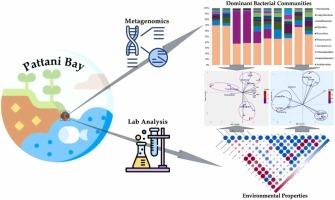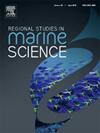16S rRNA gene profiling reveals distinct prokaryotic communities in sediment and seawater habitats of Pattani Bay, Thailand
IF 2.4
4区 环境科学与生态学
Q3 ECOLOGY
引用次数: 0
Abstract
Coastal habitats are rich in biodiversity that offer multifunctional ecosystem services. Understanding the roles of microbial dynamics and their distribution patterns is essential for ecosystem quality assessment, which, in turn, helps to decipher associated metagenomic insights. The study integrated 16S rRNA gene-targeted metagenomic data with environmental properties using sediment and seawater from selected coastal habitats (industrial, residential, protected) in Pattani Bay, Thailand. In the industrial-A habitat, both seawater and sediment had lowest mean observed OTUs (operational taxonomic units) of 428.5 and 318.0, and highest mean values were noted in residential sediment (1255.5) and industrial-B seawater (865.0). Despite sediment in the protected site having the second-highest mean OTUs (1240.0), seawater had the second-lowest by 345 OTUs. The dominant prokaryotes were Proteobacteria, Bacteroidota, Campylobacterota, Firmicutes, and Actinobacteriota, accounting for 82.8 % of the total community load. Sediments were enriched with Marinobacter, Sulfurimonas, Thiomicrorhabdus, Sulfurovum, and Rheinheimera genera, while seawaters were dominated by genera Pseudomonas, Shewanella, Bacillus, Rheinheimera, and Flavobacterium, respectively. Key sediment parameters having strong interplay with dominant taxa were soil texture, EC, and OM, and key seawater parameters included salinity, BOD5, and PO43-. PCA identified the influence of these environmental parameters on specific prokaryotic communities. High pollution load index of Industrial-A site may have contributed to lowest prokaryotic diversity, suggesting substantial influence of heavy metals. The current study revealed that prokaryotic composition was sensitive to unique environmental properties induced by local human-driven activities. Hence, all findings will contribute a strong theoretical basis for future coastal ecosystem quality assessments.

16S rRNA基因图谱揭示了泰国北大年湾沉积物和海水生境中不同的原核生物群落
沿海栖息地生物多样性丰富,提供多功能生态系统服务。了解微生物动力学及其分布模式的作用对于生态系统质量评估至关重要,这反过来又有助于破译相关的宏基因组见解。该研究将16S rRNA基因靶向宏基因组数据与泰国Pattani湾选定的沿海栖息地(工业、住宅和受保护)的沉积物和海水的环境特性相结合。在工业a区,海水和沉积物的平均OTUs最低,分别为428.5和318.0,居住沉积物和工业b区海水的OTUs最高,分别为1255.5和865.0。沉积物的平均otu值为1240.0,位居第二,海水的平均otu值为345。优势原核生物为变形菌门、拟杆菌门、弯曲菌门、厚壁菌门和放线菌门,占总群落负荷的82.8 %。沉积物中富集了Marinobacter、sulimonas、Thiomicrorhabdus、Sulfurovum和Rheinheimera属,而海水中分别以Pseudomonas、Shewanella、Bacillus、Rheinheimera和Flavobacterium属为主。与优势类群相互作用较强的关键泥沙参数为土壤质地、EC和OM,关键海水参数为盐度、BOD5和PO43-。PCA鉴定了这些环境参数对特定原核生物群落的影响。a区污染负荷指数高可能是原核生物多样性最低的原因,表明重金属污染对原核生物多样性的影响较大。目前的研究表明,原核组成对局部人类活动诱导的独特环境特性非常敏感。因此,所有研究结果将为未来沿海生态系统质量评价提供强有力的理论基础。
本文章由计算机程序翻译,如有差异,请以英文原文为准。
求助全文
约1分钟内获得全文
求助全文
来源期刊

Regional Studies in Marine Science
Agricultural and Biological Sciences-Ecology, Evolution, Behavior and Systematics
CiteScore
3.90
自引率
4.80%
发文量
336
审稿时长
69 days
期刊介绍:
REGIONAL STUDIES IN MARINE SCIENCE will publish scientifically sound papers on regional aspects of maritime and marine resources in estuaries, coastal zones, continental shelf, the seas and oceans.
 求助内容:
求助内容: 应助结果提醒方式:
应助结果提醒方式:


